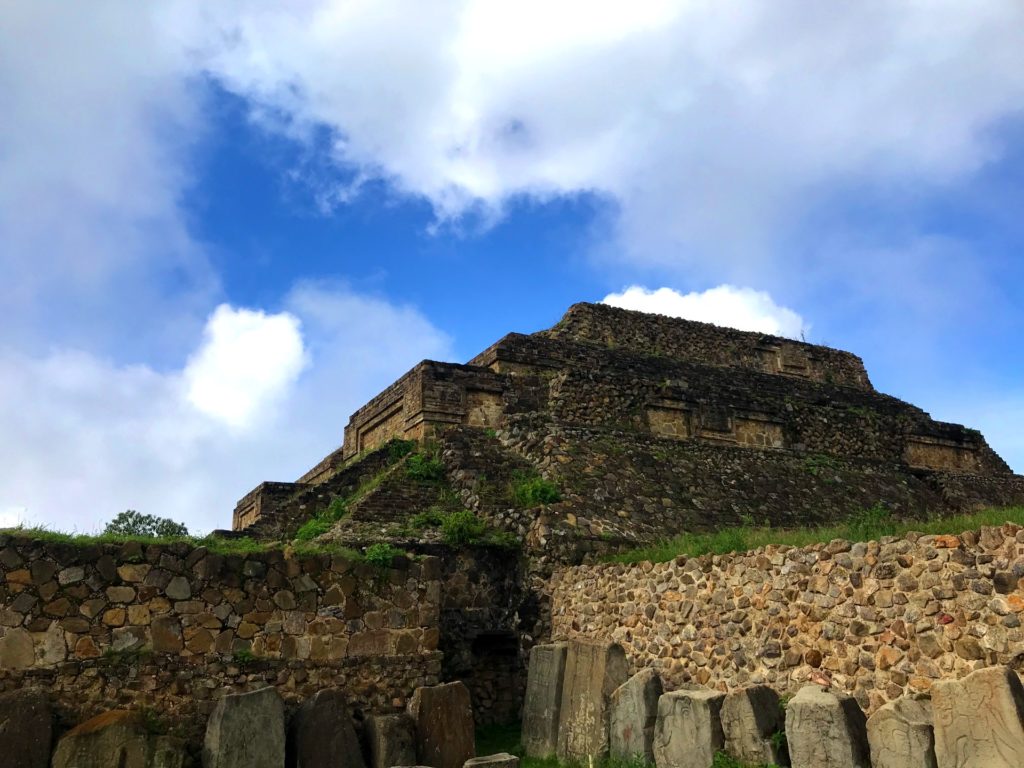Words and Photos: Indi Blake
Roughly 100 years before the fall of Sparta in ancient Greece, a group of indigenous Americans in the southern Mexican highlands were establishing one of the greatest civilizations in the western hemisphere. Their crowning achievement- a massive city built out of thousands of stone slabs assembled at 6,400 feet elevation atop a mountain overlooking the Central Oaxaca Valley (pronounced Wah-Ha-Kah). Many of the customs and traditions pioneered in this area roughly 2,500 years ago continue to be practiced by people living there today, echoing the splendor of a bygone golden era.
While never gaining the widespread recognition of new world cultures encountered by European conquistadores like the Incan or Aztec empires in Peru and Central Mexico, the Zapotec civilization stands out for its early emergence and remarkably long reign. Incan and Aztec civilizations, while incredible in their own right, did not emerge until around 1,400 CE and 1,300 CE, respectively, at least 1,800 years after the Zapotecs began construction on their city masterpiece, Monte Albán. The Zapotecs are rivaled only by the Olmecs in terms of early emergence in Meso-America, and once established, they enjoyed an unprecedented 1,000 years of relatively uninterrupted prosperity before cracks in their society began to form.
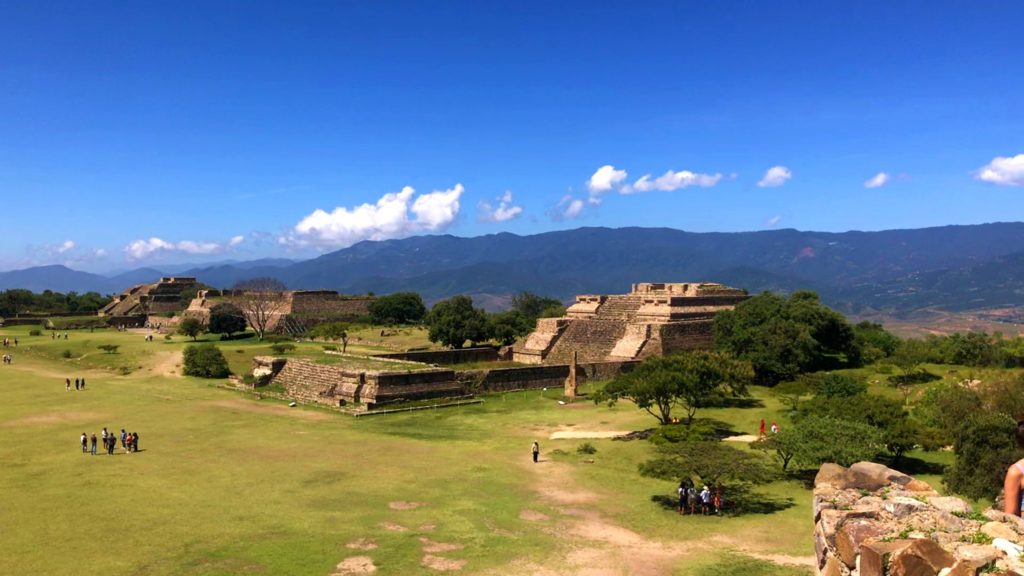
Around 10,000 years ago, long before the Zapotecs at Monte Albán or any known major civilization for that matter, the key to modern society was being forged in the Americas. Farmers in central Mexico began to selectively breed a wild grass called teosinte for larger and larger kernels until, eventually, they produced a robust fruiting cob rich with carbohydrates and minerals. Today, corn is the most heavily farmed crop in the world, out-weighing rice and wheat at over 1.2 billion metric tons harvested annually. It is thanks in large part to this humble crop and its original farmers that our planet has been able to sustain our ever-growing population.
One of the oldest pieces of evidence of corn cultivation is a single cob dating back 5,000 years ago, found in a cave just 30 miles from Monte Albán. The area’s fertile land and local people’s adoption of agriculture initiated a transition away from the nomadic style of living that had dominated since humans first set foot on the continent. Agriculture and specifically corn, fueled a shift to a more sedentary agrarian lifestyle that spread across the mountains and valleys in what is today Oaxaca state. Around 500 BCE, a mysterious force compelled a number of these uncentralized farming chiefdoms to suddenly join together to build a mighty city fortress. Whether pressure from marauding bands of outsiders, charismatic and ambitious leaders, or simply a civic need for central government, the exact reasons for Monte Albán’s rapid construction are still a matter of debate. What is known is that for the next thousand years, Monte Albán would stand as the powerful center of the Zapotec world.
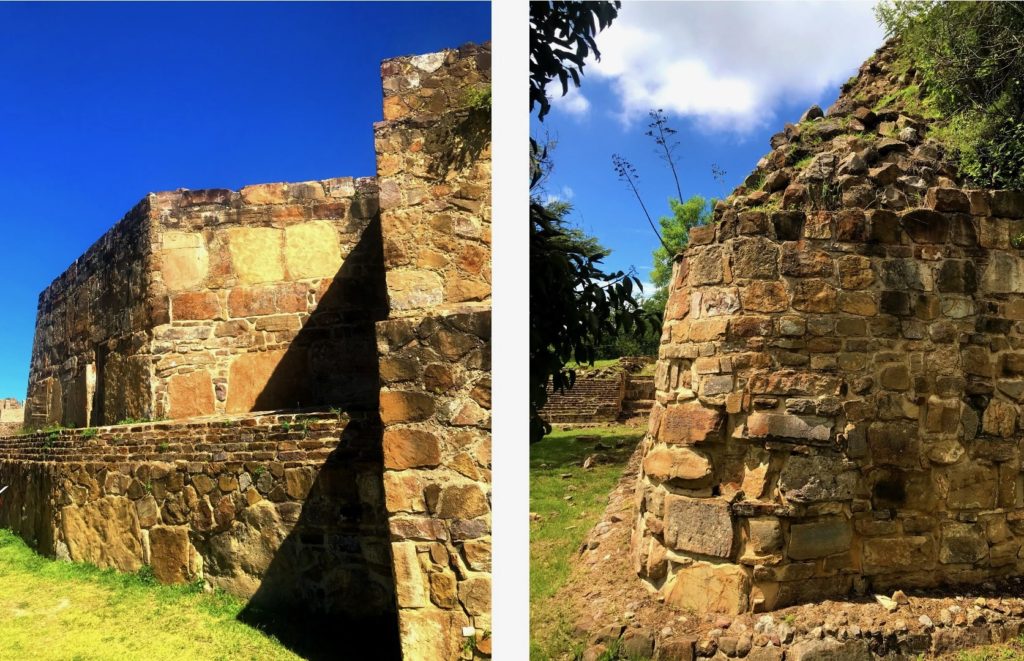
What the Zapotecs achieved at Monte Albán is on par with Stonehenge in the United Kingdom or the Colosseum in Rome. Visitors to the site often marvel at the size and scale of the ancient city’s structures without realizing that in order to build them, workers first needed to level the entire top of the mountain. Only after digging out thousands of tons of rock and dirt, literally moving mountains, could workers begin the city’s construction on a flat surface.
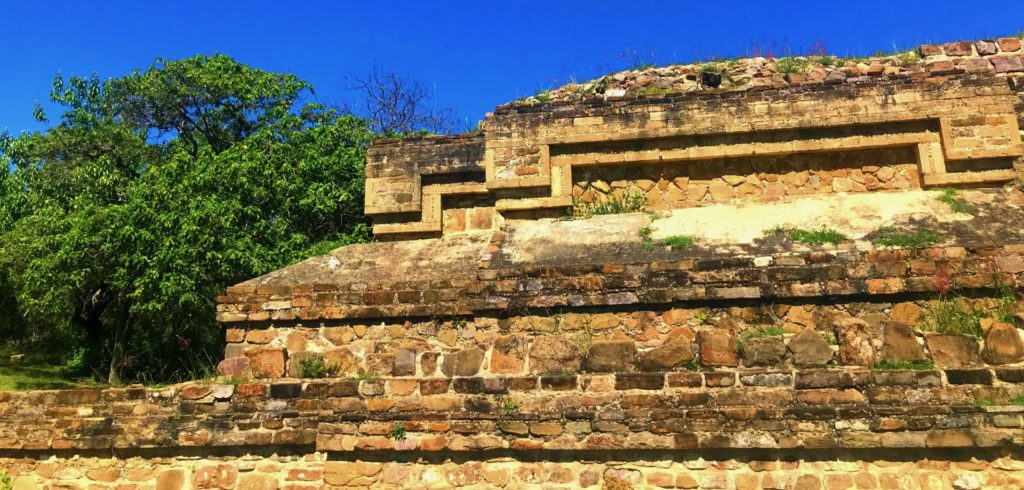
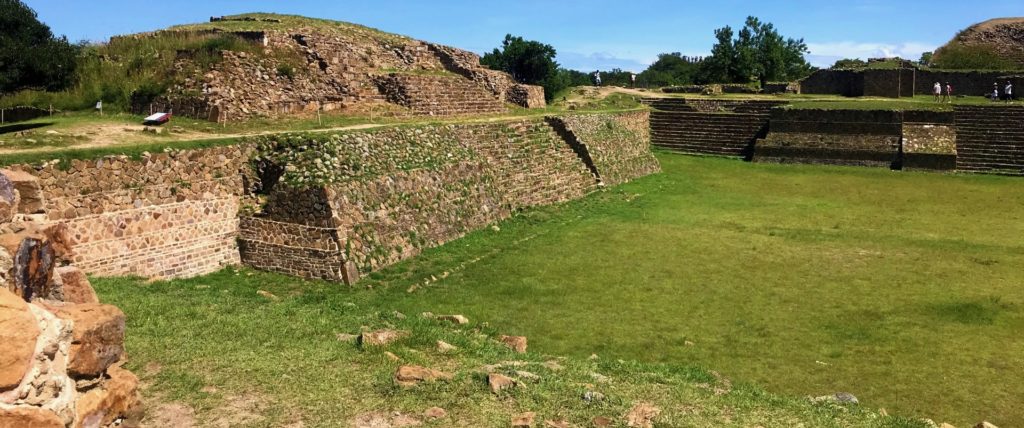
At the site, dozens of massive structures, oriented into a large rectangle approximating the cardinal directions, form a grand plaza roughly 980 feet long by 500 feet wide. On either end, grand staircases lead up to raised platforms some 50 feet up that overlook the rest of the city. The Zapotec architects at Monte Albán believed that by building the seat of their empire on the top of a mountain, they would be closer to the gods. In addition, the location was ideal for defending against would-be invaders from any direction. The style of pyramids atop the mountain at Monte Albán differs significantly from those of other pre-hispanic Mexican cultures. The towering Mayan pyramids, for example, were built from the flat Yucatecan terrain to reach past the dense jungle canopy giving them a thinner, taller look. Monte Albán, instead, is more sprawling, characterized by shorter and wider pyramidal structures. The masonry used is sandstone, quarried nearby and painstakingly cut to shape before being hauled up and set into place.
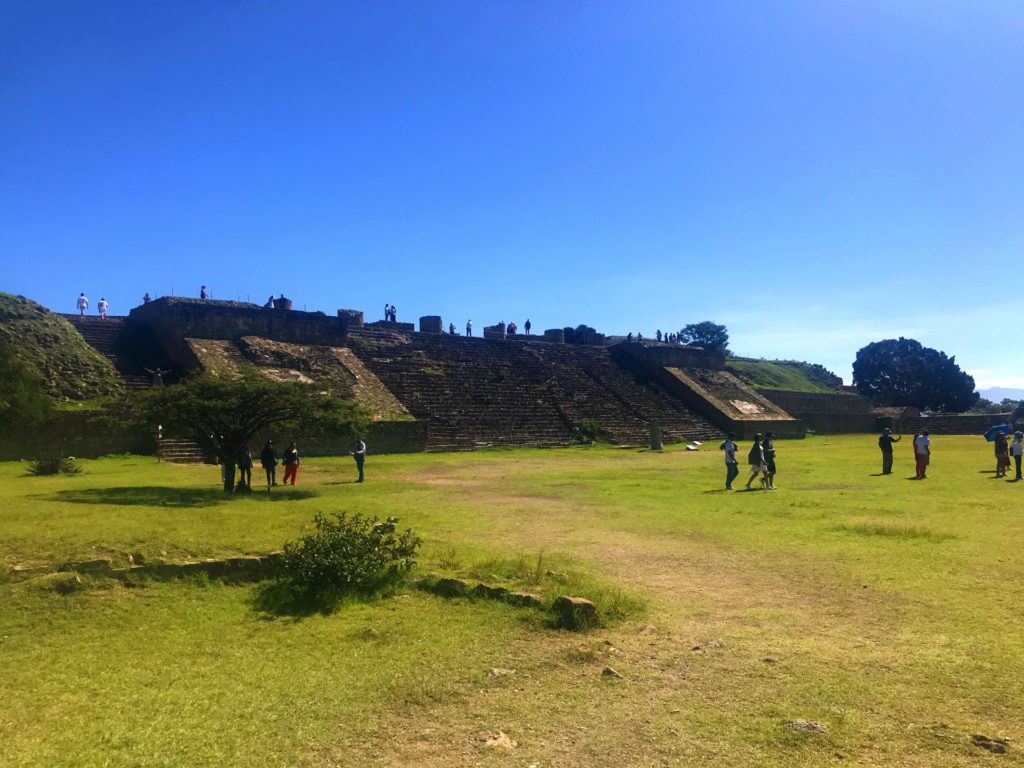
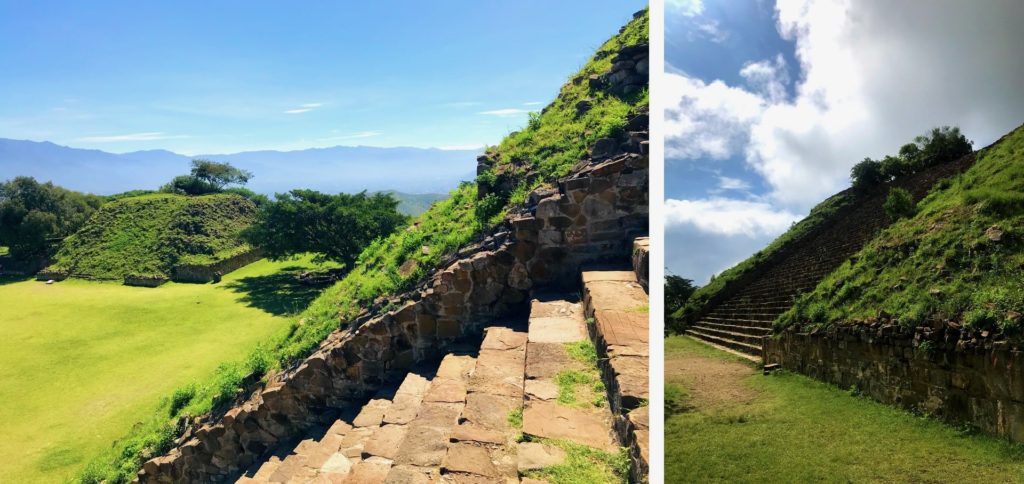
In addition to the many pyramids, sturdily built palaces, with walls up to three feet thick, housing many rooms that were used as living quarters for the elite, are scattered throughout the site. Some of these palaces were intentionally built overlooking common areas suggesting a stratified social hierarchy. A wall built around the city reaching 30 feet high in some places gives further insight as to the disparate power structure favoring those fortunate enough to live within the city. For those lucky enough to reside within its walls, the splendor of the city would have been amazing. Traces of archeological remnants reveal that during its heyday, much of the city would have been painted in white plaster and decorated with elaborate drawings and murals. Spectators would have watched from bleachers made of stone as athletes jockeyed for dominance during games played in the city’s massive ball court, and traders and merchants would have gathered to exchange goods during busy days at the market.
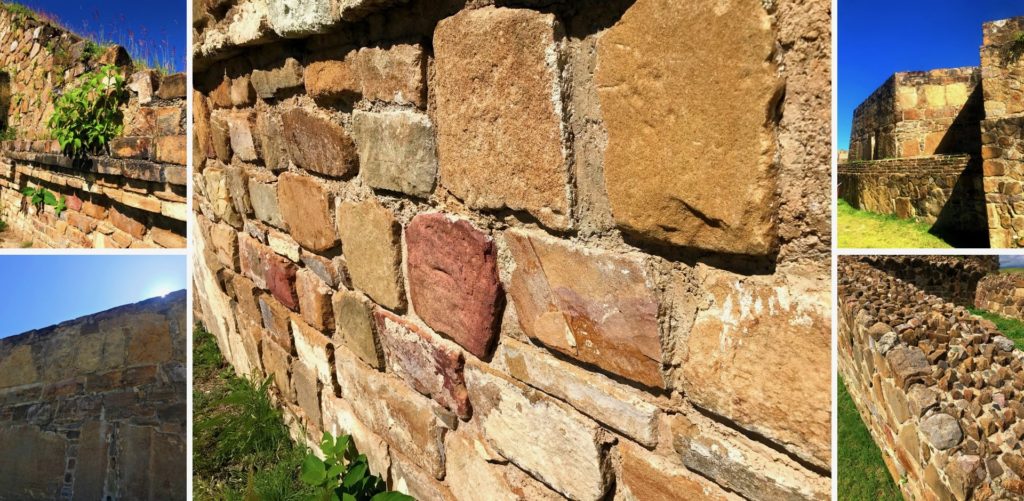
With agriculture playing an integral role in sustaining such growth and prosperity, a deep cultural reverence for annual seasons and solar patterns developed. Structural features seen in Monte Albán’s architecture reflect the astronomical significance and a keen awareness of the heavens. In one grand staircase, a small cavity leading deep into the structure is thought to have been used as a guide to the seasons. Every year on a specific date, the sun would shine at just the right angle to reach the floor far below, possibly marking the date of a special celebration, crop harvest or simply denoting the new year.
Within 200 years of its founding, the population at Monte Albán had exploded to over 5,000 people, numbers unseen before for a single city in this region of Mexico, and while it would continue to grow and change, the city’s general layout would largely remain the same. Over the next decades and centuries, the city’s population continued to rise, eventually marking between 17,000-25,000 residents. With greater numbers came greater wealth for the elites, reflected in the extravagant grandeur of artifacts discovered at the site and spectacular offerings found buried in tombs. The Zapotecs cherished precious materials like gold, silver and jade stone. Skilled craftsmen created complex alloys and developed methods of cutting and polishing stones to create beautifully ornate trinkets and jewelry. Evidence of fine art, astronomical knowledge and successful conquest left at Monte Albán paint a picture of a powerful urban center whose control extended for miles in every direction.
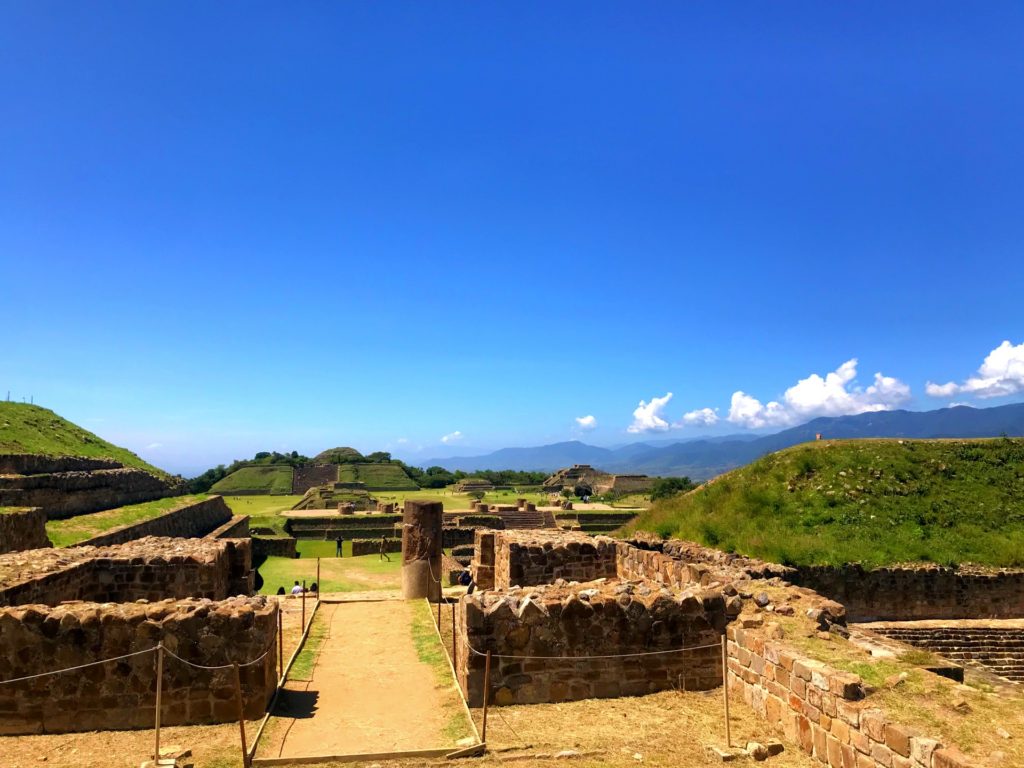
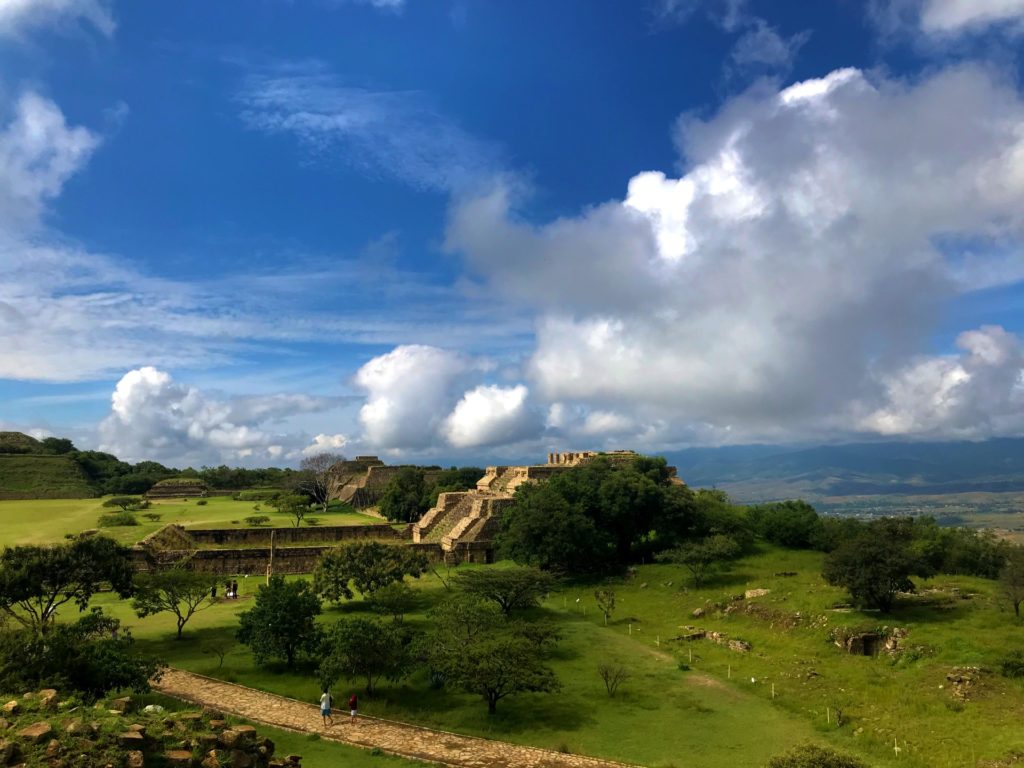
Far to the northwest, near what would eventually become Mexico City, a new center of power was emerging. The city of Teotihuacan, then in its infancy, began trading with the legendary Zapotec city to its south, creating enormous spoils for both civilizations. Amazingly, archeologists studying Teotihuacan, some 250 miles from Monte Albán, have discovered a section of the city that appears to have been inhabited exclusively by Zapotecs, evidenced by their unique styles of building, art and ritual left behind. In the same manner, evidence of Teotihuacan-styled artifacts have been found at Monte Albán, hinting at the intensely close relationship between these two great ancient civilizations.
Within 500 years, the Zapotecs had expanded far beyond their initial city stronghold. The surrounding valleys bustled with small villages supporting populations likely numbering in the millions. Many prominent satellite cities were conquered and brought under the control of the lords of Monte Albán. Within the rooms of a building at Monte Albán known as Building J or “The Observatory,” named for its suspected use in astronomy, giant stone tablets are etched with the names of neighboring city sites. Under many of these names, an upside-down head has been carved, menacingly suggesting the fate of the previous leaders of each outpost. Another archaeological discovery at Monte Albán became the source of a morbid realization. Hundreds of huge carved stone monuments, each weighing upwards of five hundred pounds lining the edges of the main plaza dubbed “Los Danzantes” or “The Dancers” for years, were thought to depict ritual dances. Modern archaeologists have since revised their theory, now seeing the depictions as torture scenes of mutilated enemies. The once lighthearted caricatures of contorted bodies in odd positions now take on a much darker tone.
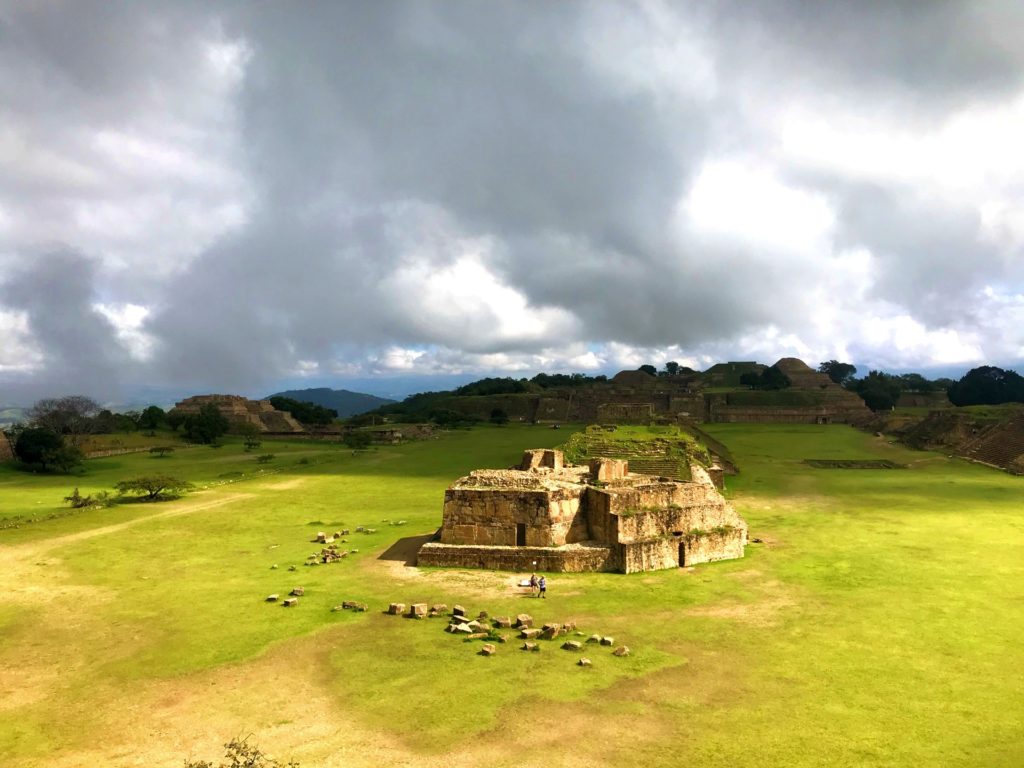
Just like many successful civilizations throughout history, the Zapotecs engaged in conquest and expansion, that was the cause of significant bloodshed. However, their amazing craftsmanship and rich culture juxtapose their sordid history in a profound way. The decorated masonry found at Monte Albán is a testament to the beauty of the culture, as are the countless ceramic trinkets, jewelry and figurines produced by long since forgotten artists. Production of such artifacts began to slow down around 500-750 CE, roughly the same time the culture as a whole began to deteriorate.
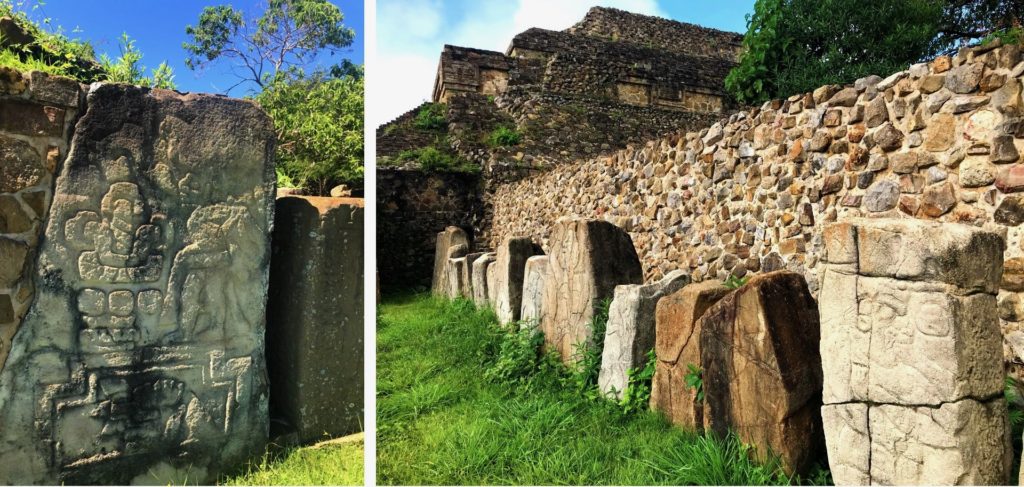
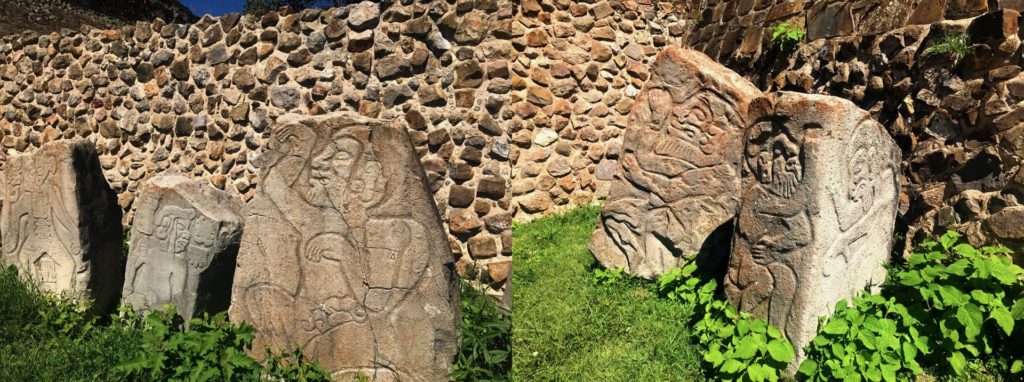
Another distinct group with its origins nearby, the Mixtecs, had been gaining power in the region and had begun to loosen the stranglehold the Zapotecs had on the area. The golden era of the Zapotec empire was at its end, and their influence dwindled for the next few centuries as Mixtec influence grew. The reign of the Zapotecs at Monte Albán eventually came to an end with the abandonment of the great city around 750 CE. For comparison, the USA has only existed for 250 years, merely 25% of the time that the Zapotecs thrived in Monte Albán. For the next few hundred years, while nearby cities gained prominence, Monte Albán remained essentially uninhabited. By the 1300s, the city was a shell of what it once was, occasionally being used by the Mixtecs, groups of whom had moved in and made renovations to the city, building up certain areas and augmenting aspects of the architecture to better suit their own rituals and religion. Unfortunately, many of the valuable artifacts, including codices and texts that detailed Zapotec life, were destroyed or lost during this period. Zapotec burial sites were unearthed and replaced by Mixtec burials reusing many of the original Zapotec relics for their own burial offerings. Despite the rich and colorful Mixtec culture rising to prominence, Monte Albán would never again hold the same power. The influence of the original Zapotec culture, however, would continue to be inextricably woven into the region.
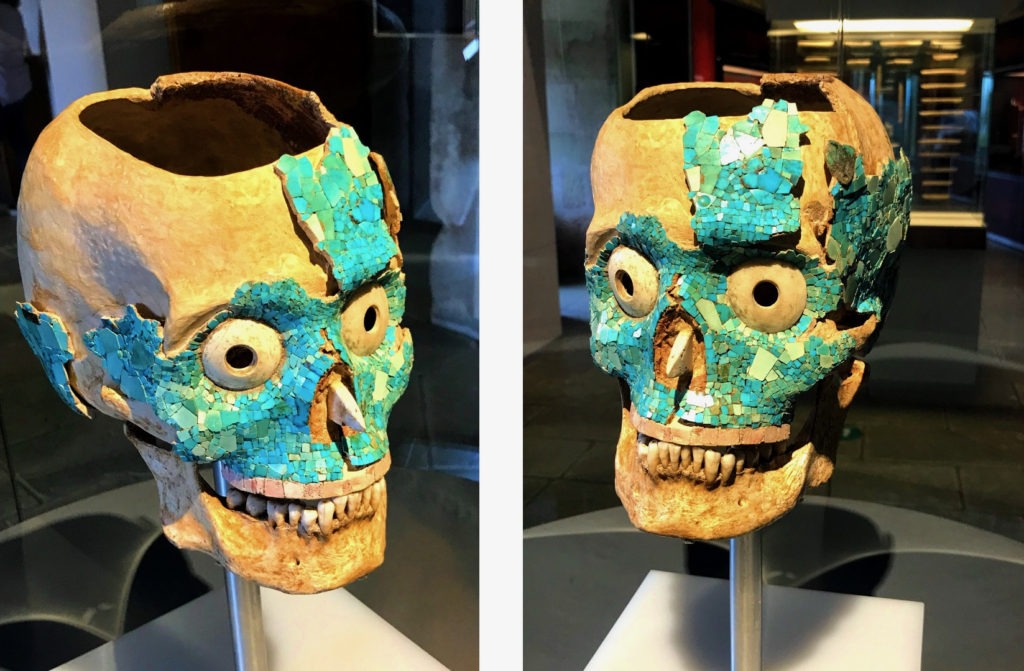
By the time the Spanish Conquistadors arrived in 1521 on a special mission ordered by Hernan Cortez himself, the Mixtecs had become the dominant force in the region, with Zapotecs and other groups maintaining a significant albeit smaller presence. No longer hosting a societal superpower, the Oaxaca Valley had become less united and was feeling the pressure of the immense new Aztec civilization that had replaced Teotihuacan in the Northeast. Cortez had been told by the Aztec king Moctezuma II that the Oaxaca region was flush with gold, and Cortez, true to character, intended to extract it all. The people of the Oaxaca Valley attempted diplomacy rather than warfare with the Spanish but disease brought from Europe, namely smallpox, decimated the population.
The Spanish quickly brought the urban center of the Oaxaca Valley under their control and erected a church on the valley floor. Some indigenous leaders hoping to gain favor with the new power in the area opted to get baptized and began to convert their followers to Christianity. Not all were willing; however, many groups fled to the surrounding hills. Occasional uprisings from native people were squashed by the Spanish with their superior technology and newfound allies. Many of the groups who migrated to the surrounding hills continued to resist, and some remained isolated there until Mexico’s independence in 1821.
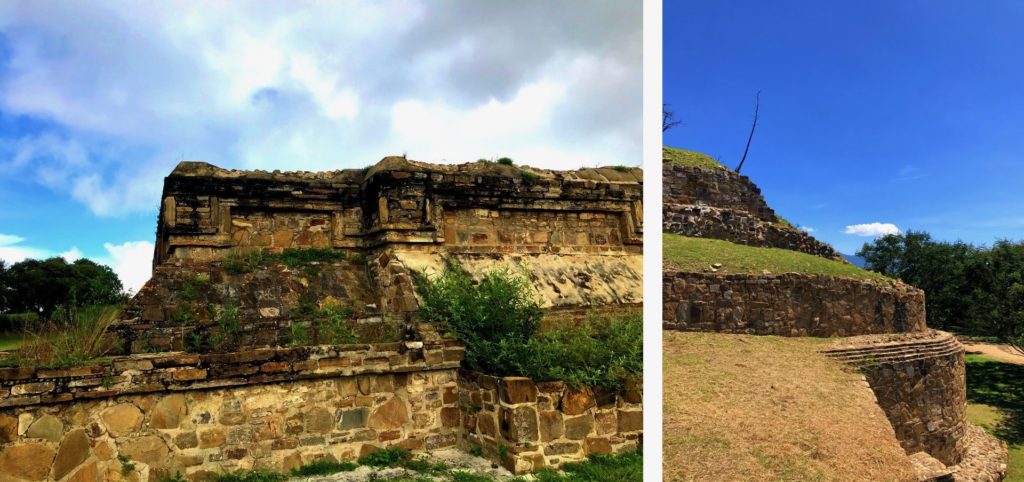
Today, Monte Albán stands atop the mountain sculpted by ancients 2,500 years before, still overlooking the city of Oaxaca. Even within the context of today’s world, its massive structures evoke awe in those who are fortunate enough to visit. The site was named a UNESCO World Heritage Site in 1987 and hosts thousands of visitors each year. Both Mixtec and Zapotec peoples still inhabit the surrounding areas, and tales of grandeur from ancient times, possibly referencing the golden age of Monte Albán, continue to be passed down orally. The tale of Monte Albán’s rise and its eventual fall is intertwined with the story of human history. Representing one of the earliest advanced civilizations on the continent, what the Zapotecs achieved at Monte Albán is a proud testament to the triumph of our species.
